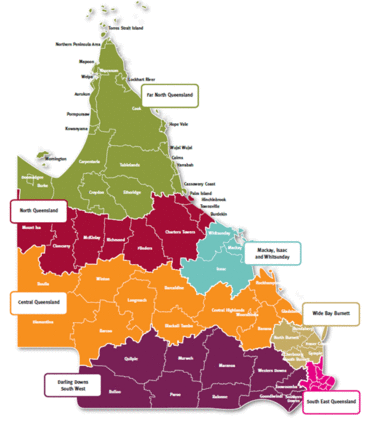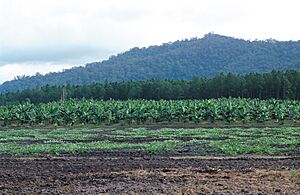Far North Queensland facts for kids
Quick facts for kids Far North QueenslandQueensland |
|||||||||||||||
|---|---|---|---|---|---|---|---|---|---|---|---|---|---|---|---|

Queensland regions
|
|||||||||||||||
| Population | 280,638 (2010 est.) | ||||||||||||||
| • Density | 0.7370696/km2 (1.909002/sq mi) | ||||||||||||||
| Area | 380,748.3 km2 (147,007.7 sq mi) | ||||||||||||||
| LGA(s) | Aurukun, Burke, Cairns, Carpentaria, Cassowary Coast, Cook, Croydon, Doomadgee, Douglas, Etheridge, Hope Vale, Kowanyama, Lockhart River, Mapoon, Mareeba, Mornington, Napranum, Northern Peninsula Area, Pormpuraaw, Tablelands, Torres Strait Islands (not autonomous), Torres Strait Islands (autonomous), Weipa, Wujal Wujal, Yarrabah | ||||||||||||||
| State electorate(s) | Electoral district of Barron River, Electoral district of Cairns, Electoral district of Cook, Electoral district of Dalrymple, Electoral district of Hinchinbrook, Electoral district of Mulgrave | ||||||||||||||
| Federal Division(s) | |||||||||||||||
|
|||||||||||||||
Far North Queensland (often called FNQ) is the northernmost part of the Australian state of Queensland. Its biggest city is Cairns. The region is mostly covered by the Cape York Peninsula, which stretches north towards the Torres Strait and west to the Gulf Country. The waters of the Torres Strait form Australia's only land border with another country, Papua New Guinea.
This amazing region is home to three World Heritage Sites. These are the famous Great Barrier Reef, the beautiful Wet Tropics of Queensland rainforests, and Riversleigh. Riversleigh is Australia's largest site for ancient mammal fossils. Far North Queensland also has over 70 national parks. One of these is Mount Bartle Frere, which at 1,622 metres is the highest mountain in both Queensland and Northern Australia.
Far North Queensland is special because it's the only part of Australia that is the traditional home of both Aboriginal Australians and Torres Strait Islanders. The region is also important for farming, mining, and has Queensland's largest wind farm, the Windy Hill Wind Farm.
Contents
What is Far North Queensland?

Different government groups define the exact borders of Far North Queensland in slightly different ways. Generally, it covers a large area made up of 25 local government areas. These include major places like Cairns, Cook, Douglas, and the Tablelands. It also includes many Aboriginal and Torres Strait Islander communities.
Main Towns and Areas
The main city and administrative centre of Far North Queensland is Cairns. Other important towns and areas include Cooktown, the Atherton Tableland, Weipa, Innisfail, and the Torres Strait Islands. Many Aboriginal communities and farming groups also live throughout the region.
A major road, Highway 1, passes through Cairns. This highway connects the Bruce Highway, which runs south, to the Savannah Way, which goes west. Highway 1 is the longest national highway in the world, circling the entire continent for about 14,500 kilometres. However, not all parts of the Savannah Way are fully paved.
Industries and Jobs
Far North Queensland has several important industries. These include tourism, raising cattle, farming, and mining. Farming brings in between $600 and $700 million each year. Farmers grow crops like sugar cane, and many different tropical fruits such as bananas, mangoes, papaya, lychees, and coffee.
The region is home to the world's largest silica mine at Cape Flattery. This mine started in 1967. There is also a large bauxite mine near Weipa, on the western coast of Cape York Peninsula. This area has one of the biggest bauxite deposits in the world.
In recent years, Far North Queensland has also become known for its arts and culture. Events like the Cairns Indigenous Art Fair and Cairns Festival happen every year. Important arts places include the Tanks Arts Centre, Cairns Civic Theatre, and Cairns Art Gallery.
Tourism in Far North Queensland
Tourism is a huge industry here, making Far North Queensland a top holiday spot in Australia. Almost one-third of all international visitors to Queensland come to this region.
Some of the most popular attractions are:
- The amazing Great Barrier Reef.
- The ancient Daintree Rainforest and other tropical rainforests within the Wet Tropics of Queensland heritage area.
- The cooler Atherton Tableland.
- Islands like Hinchinbrook Island, Dunk Island, and Green Island.
In and around Cairns, you can visit the Cairns Aquarium, Cairns Botanic Gardens, and The Reef Hotel Casino. You can also take a ride on the Kuranda Scenic Railway or the Skyrail Rainforest Cableway to see Barron Falls. Other popular places for tourists include Cape Tribulation, Port Douglas, Mission Beach, and Cardwell.
People and Culture
In 2014, about 280,638 people lived in Far North Queensland. A large part of the population, about 11.8%, are Indigenous people. This means about 28,909 Indigenous people live in the region.
Because Far North Queensland is close to Melanesia, there are also many Melanesians living here. Many of them are from Papua New Guinea or are South Sea Islanders. South Sea Islanders are descendants of workers who were brought to Queensland from places like Fiji, the Solomon Islands, and Vanuatu a long time ago. Cairns has the largest population of Papua New Guineans outside of Papua New Guinea itself.
History of the Region
Far North Queensland has a rich history, including many traditional Aboriginal languages. Some of these languages include:
- Yalanji (also known as Kuku Yalanji) spoken around the Mossman River and Annan River.
- Warungu (also known as Warrungu) spoken from the Upper Herbert River to Mount Garnet.
- Yir Yiront spoken in Western Cape York.
- Yidinji spoken around the Cairns and Tablelands areas.
The first amber fossils found in Australia were discovered in Far North Queensland. These four-million-year-old fossils were found on a beach in Cape York Peninsula. In the 1860s, Richard Daintree found gold and copper here, which brought many early miners to the area. Many mining towns grew quickly and then disappeared as the mines ran out.
A sad event in the region's history was the Mount Mulligan mine disaster on September 19, 1921. Seventy-five workers died, making it one of Australia's worst coal mining accidents.
Cyclones and Weather Events
Far North Queensland has experienced some powerful cyclones. The worst maritime disaster in Queensland happened here on March 4, 1899. The Mahina Cyclone destroyed all 100 ships in Princess Charlotte Bay. About 307 men from the pearling fleet and 100 Aboriginal people helping survivors drowned. This cyclone had a record-breaking tidal surge of 13 metres.
Other significant cyclones include:
- The 1918 Mackay cyclone in January 1918, which killed 30 people.
- Cyclone Justin in March 1997, which caused seven deaths.
- Cyclone Steve in early 2000, which led to major flooding.
- Cyclone Larry in March 2006, which caused about $1.5 billion in damage and destroyed 80% of Australia's banana crop.
- Cyclone Monica in April 2006, the most intense cyclone on record for wind speed to cross the Australian coast.
- Cyclone Yasi in January 2011, which caused an estimated $3.6 billion in damage, making it the costliest cyclone to hit Australia.
- Cyclone Jasper in December 2023, which caused record rainfall and major floods in Cairns.
Amazing Animals
Far North Queensland is home to many unique native animals. You can find:
- Crocodiles
- Endangered southern cassowaries (large, colourful birds)
- Koalas
- Waddling wombats
- Flying possums
- Pythons
- Water dragons
- Wallabies
- Flying foxes (large bats)
- Tree kangaroos
- Platypuses
- Leaf-tailed geckos
- Bandicoots
Tropical North Queensland Name
Because Far North Queensland has a tropical climate, the name Tropical North Queensland is also often used. This name is especially popular in the tourism industry. Tourism Tropical North Queensland (TTNQ) defines this area as stretching from Cardwell in the south up to the Torres Strait in the north and west to the border with the Northern Territory. However, sometimes the phrase "Tropical North Queensland" might be used to describe an even wider area.



